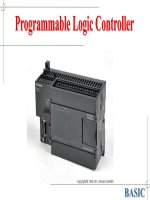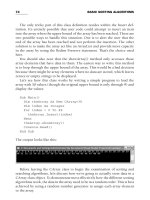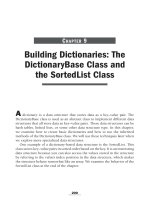lesson1 tekla structures basic training
Bạn đang xem bản rút gọn của tài liệu. Xem và tải ngay bản đầy đủ của tài liệu tại đây (2.27 MB, 50 trang )
Tekla Structures Basic
Training
Tekla Structures 10.0
February 13, 2004
Copyright © 2004 Tekla Corporation
Contents
1 Basic Modeling 3
1.1 Starting Tekla Structures 4
1.2 Create a New Model – BasicModel1 5
1.3 Create Grids 8
1.4 Create Plane Views along Grid Lines 10
1.5 Create Foundations 14
Column Footing 15
Foundations for Silos – Parametric Profiles 17
1.6 Create Steel Members 21
Columns 21
Silos 23
Level 3850 Beams 25
Copy Beams to Upper Levels 27
Level 13400 Beams 29
Bracing 36
1.7 Create Concrete Members 40
Concrete Hollow Core Slabs 41
Copy Concrete Hollow Core Slabs to Levels 7350 and 3850 43
Concrete Slab 44
TEKLA STRUCTURES BASIC TRAINING
i
Basic Modeling
1 Basic Modeling
We will go through the basic functions of Tekla Structures: How to
create a new structural 3D model, how to create grids (i.e. module
lines), grid views and structural members in the model. As a result of
this lesson the model will look as shown below.
In this lesson
TEKLA STRUCTURES BASIC TRAINING
3
Basic Modeling
1.1 Starting Tekla Structures
To start Tekla Structures, click the Windows Start button. Navigate
through
Programs > Tekla Structures > Singleuser > Tekla Structures enu
Europe
. This will start Tekla Structures in European environment using
English language.
Starting Tekla
Structures
The modeling user interface is now opened. At first, most of the menu
options and all the icons are gray indicating that they are inactive. When
you open an existing model or create a new model, the icons and
available menu options become active.
4
TEKLA STRUCTURES BASIC TRAINING
Basic Modeling
1.2 Create a New Model –
BasicModel1
To start a new model, you first need to create an empty model database
with a unique name. In this lesson use the name BasicModel1.
1. Select File > New… from the pull-down menu or click the New model icon
in the
Standard toolbar to open the New model dialog box.
Start a new model
2. At the lower left corner of the dialog box, Tekla Structures suggests the
name New Model for the model. The full path of the model folder is shown
in this field.
3. Click after the folder path, for example
C:\TeklaStructuresModels\ and
replace the New Model name by
BasicModel1. Accept the default option
of Tekla Structures to
Create default view and grid.
TEKLA STRUCTURES BASIC TRAINING
5
Basic Modeling
4. Click the
OK button to create the new model.
The menus and icons become activated and the model name appears in
the title bar of the Tekla Structures window.
Every model must have a unique name. Tekla Structures
does not allow duplicate model names. Do not use special
marks ( / \ ; : | ) in model names.
You can only have one model open at a time. If you already
have a model open, Tekla Structures prompts you to save
that model.
As we had the
Create default view and grid checkbox selected, Tekla
Structures automatically created a grid and a view according to the
saved standard view properties. The default 3D view and grid are shown
below.
Cyan dash-and-dot lines show the projections of the grids which are
visible on the view plane. Tekla Structures indicates the work area of a
view using green, dashed lines. For more information, see:
Help:
Modeling > Getting started > Basics
.
6
TEKLA STRUCTURES BASIC TRAINING
Basic Modeling
To save the model:
Save the model
Select File > Save from the pull-down menu or click the Save icon in the
Standard toolbar.
Remember to save your model every now and then, and
always when opening another model or exiting Tekla
Structures.
Tekla Structures includes also an auto save feature that backs up and
saves your work automatically at set intervals. These are set in the
Autosave properties dialog box obtained from the Setup > Autosave…
pull-down menu.
For more information on saving and auto saving, see:
Help: Modeling > Getting started > Saving a model and exiting Tekla
Structures
Most commands of Tekla Structures are found both in menus (main or
pop-up) and in toolbars (icons). In this training manual we will mainly
use the pop-up menu to activate commands.
There are several ways to execute commands in Tekla
Structures:
• Icons
• Commands in main pull-down menu
• Commands in pop-up menu
By default all the commands are found in pull-down menu,
most of them in the icons. A pop-up menu appears when
you click the right mouse button (right-click). If you have
an object selected, the commands on the pop-up menu
relate to that object.
For more information on Tekla Structures screen layout and toolbars,
see:
Help: Modeling > Screen layout
Help: Modeling > Toolbars
TEKLA STRUCTURES BASIC TRAINING
7
Basic Modeling
1.3 Create Grids
To create the appropriate grid for BasicModel1 as shown above, you can
delete the existing grid and create a new one from the
Points > Grid…
pull-down menu. Alternatively you can modify the existing grid.
To modify the existing grid:
Modify the
existing grid
1. Double click the grid line.
2. Complete the appearing
Grid dialog box as shown below by filling in the
X, Y and Z coordinates and the labels for the grid lines.
8
TEKLA STRUCTURES BASIC TRAINING
Basic Modeling
3. Click Modify to apply the new grid values.
4. Enter the grid file name, GRID1, and click the Save as button to save the
grid values for later use. The file GRID1.grd appears in the
attributes
subfolder of your model folder.
For more information on grids and dialog box buttons, see:
Help: Modeling > Introduction > Inputting information > Common
buttons
The number of decimals used in the Grid dialog box (as
well as in other modeling dialog boxes) can be controlled
from the Units and decimals dialog box obtained from the
Setup pull-down menu.
When the grid was modified, the work area of the view, shown with the
green dashed line, was not updated.
To fit the work area according to the modified grid:
Fit work area
1. Click the view.
2. Right-click and select
Fit work area from the pop-up menu.
The view should now look as shown below:
TEKLA STRUCTURES BASIC TRAINING
9
Basic Modeling
1.4 Create Plane Views Along Grid
Lines
We will now create Elevation and Plan views along the grid lines
created in the previous section.
A view is a representation of a model from a specific location. Each
view is displayed in its own window inside the Tekla Structures
window. Each view has a view plane on which the grids are visible and
points are represented as yellow crosses. Points outside the view plane
appear as red dots.
For more information, see:
Help: Modeling > Getting started > Views.
To create views along grid lines,
Create grid views
1. Select one grid line.
2. Right-click and select Create view > Grid views from the pop-up menu to
open the
Creation of views along grid lines dialog box.
10
TEKLA STRUCTURES BASIC TRAINING
Basic Modeling
3. Click the
Show… button of the XY view plane to open the View
properties
dialog box.
4. Change the Angle and View depth values as shown below and click OK to
close the dialog box.
5. Select the number of views as
All and click Create in the Creation of
views along grid lines dialog box.
TEKLA STRUCTURES BASIC TRAINING
11
Basic Modeling
The Views dialog box appears presenting all the created views. All
invisible named views are listed on the left, and all visible views on the
right.
For more information on view properties, see:
Help: Modeling > Getting started > Views > View properties
To display or hide views:
Display or hide
views
1. Click the Open named view list icon to open the Views dialog box (which
is now already open).
2. Select the view(s) you want to display or hide.
3. Use the arrows to move view(s) from left to right (visible) or vice versa
(invisible).
12
TEKLA STRUCTURES BASIC TRAINING
Basic Modeling
Do not keep too many views open at the same time. Nine is
the maximum number of open views. You can open or
close named views by clicking the Open named view list
icon. Delete unnecessary views from the view list.
To switch between views, press Ctrl+Tab.
You can rotate the model in a 3D view with rendered view type.
Rotate the model
1. Press the key V.
2. In the view, pick a center of rotation.
3. Hold down the
Ctrl key, and click and drag with the middle mouse button.
TEKLA STRUCTURES BASIC TRAINING
13
Basic Modeling
With the shortcut Ctrl+P you can change the view angle between 3D and
Plane, which is very useful.
Change between
3D / Plane
1.5 Create Foundations
We will now create foundations for the BasicModel1.
14
TEKLA STRUCTURES BASIC TRAINING
Basic Modeling
Column Footing
To create footings for columns:
1800*1800 footing
1. Double-click the Create pad footing icon. This will open Pad footing
properties dialog box
2. Complete the
Pad footing properties dialog box as shown and click
Apply.
TEKLA STRUCTURES BASIC TRAINING
15
Basic Modeling
3. In the 3d view, pick the intersection of grids A-1 to create the footing.
4. Create the rest of the 1800*1800 footings at other intersections of grid line
A by picking each position.
Help: Part position
Help: Profile library / Parametric
You can undo (and redo) previous commands one by one
since the last save by clicking the icons shown or typing
Ctrl + Z (Undo) and Ctrl + Y (Redo).
While still in the command,
2700*2700 footing
5. Complete the Pad footing properties dialog box for 2700*2700 footing as
shown and
Apply this.
The footings on grid B need offsetting from the grid line because there will
be additional columns modeled afterwards. This offset will be
accomplished by adjusting the
Vertical Position value in the Pad footing
properties dialog box.
16
TEKLA STRUCTURES BASIC TRAINING
Basic Modeling
6. Create the footings at intersections of the gridline B.
7. Right click and select
Interrupt to end the command.
The commands will stay on until you interrupt them.
To end commands right-click and select Interrupt from the
pop-up menu, or press the Esc key.
To restart the last command used press Enter.
Foundations for Silos – Parametric Profiles
We will create two identical circular foundations for the silos. At first,
one foundation will be created at the coordinate 4500,4500,0 and then
the other foundation will be created as a copy of the first one.
Tekla Structures contains standard (library), parametric, and user-
defined profiles. For the foundation, we will use parametric profiles
instead of the library profiles.
Help: Modeling > Parts > Profile
TEKLA STRUCTURES BASIC TRAINING
17
Basic Modeling
Help: Modeling > Settings and tools > Appendix A: Parametric Profiles
1. Double-click the
Create pad footing icon.
Create footing
2. Complete the Pad footing properties dialog box as shown and click
Apply.
You can select the profile of a part from the Select profile
dialog box that opens next to the Profile field in the part
properties dialog box.
You can as well enter a profile name in the Profile field in
the part properties dialog box.
18
TEKLA STRUCTURES BASIC TRAINING
Basic Modeling
3. Type 4500,4500 to define the position for the footing (typing the numbers
automatically displays the
Enter a numeric location dialog box).
4. Click
Enter, and the foundation is created.
TEKLA STRUCTURES BASIC TRAINING
19
Basic Modeling
Help: Modeling > Settings and tools > Snapping
1. Click the footing once to select it.
Copy the footing
2. Right click and select Copy > Translate… from the pop-up menu.
Complete the dialog box as shown.
3. Click
Copy.
Now the footings should look like those shown below:
20
TEKLA STRUCTURES BASIC TRAINING
Basic Modeling
1.6 Create Steel Members
Columns
We will first create two of the columns and then use the Copy command
to create the other columns.
To create the first two columns:
Create columns
1. Double-click the Create column icon.
2. Complete the
Column properties dialog box as shown below, and then
click
Apply.
TEKLA STRUCTURES BASIC TRAINING
21
Basic Modeling
3. Pick the intersection of grids A-1 to create one column, and then pick grid
B-1 to create the second column.
1. Select the columns that you just created by dragging a window across
them.
Copy columns
2. Right click and select
Copy > Translate… from the pop-up menu.
Complete the dialog box as shown below and click
Copy.
22
TEKLA STRUCTURES BASIC TRAINING
Basic Modeling
Now all the columns appear in the model.
When identical structures appear in the model, you can
alternatively create one footing (and its reinforcement), the
steel column on top of it and the base plate connection
between the footing and the column, and copy this
structural entity to all other positions of similar structures.
You can select multiple parts in the model by holding down
the Ctrl-key and picking objects in the model.
Help: Modeling > Introduction > Selecting model objects > How to select
objects
Silos
We will now model the silos by using solid parametric profiles. A more
precise alternative would be to create the silo as a circular hollow
section with a contour plate welded on top of it.
1. To create the silos, double-click the Create column icon.
Create silos
2. Complete the
Column properties dialog box as shown below, and then
click
Apply.
TEKLA STRUCTURES BASIC TRAINING
23
Basic Modeling









